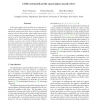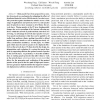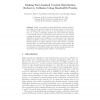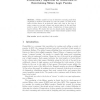124
click to vote
CVPR
2011
IEEE
14 years 4 months ago
2011
IEEE
In the square jigsaw puzzle problem one is required to reconstruct the complete image from a set of non-overlapping, unordered, square puzzle parts. Here we propose a fully automa...
WEBI
2010
Springer
14 years 10 months ago
2010
Springer
The ESP game belongs to the genre called Games with a Purpose (GWAP), which leverage people's desire to be entertained and also outsource certain steps of the computational p...
COMGEO
2004
ACM
15 years 23 days ago
2004
ACM
We present a new algorithm for automatically solving jigsaw puzzles byshapealone.Thealgorithm cansolvemore difficult puzzlesthan couldbesolved before, without the use of backtracki...
101
click to vote
ICGA
2008
15 years 29 days ago
2008
Single-player games (often called puzzles) have received considerable attention from the scientific community. Consequently, interesting insights into some puzzles, and into the a...
116
click to vote
AAAI
2007
15 years 3 months ago
2007
Solving logic puzzles has become a very popular past-time, particularly since the Sudoku puzzle started appearing in newspapers all over the world. We have developed a puzzle gene...
107
click to vote
ISAAC
2004
Springer
15 years 6 months ago
2004
Springer
Solving and designing puzzles, creating sculpture and architecture, and inventing magic tricks all lead to fun and interesting algorithmic problems. This paper describes some of o...
110
click to vote
INFOCOM
2005
IEEE
15 years 6 months ago
2005
IEEE
Abstract— Client puzzles have been proposed in a number of protocols as a mechanism for mitigating the effects of distributed denial of service (DDoS) attacks. In order to provid...
107
click to vote
ICISS
2009
Springer
15 years 7 months ago
2009
Springer
Many peer-assisted content-distribution systems reward a peer based on the amount of data that this peer serves to others. However, validating that a peer did so is, to our knowled...
EVOW
2010
Springer
15 years 7 months ago
2010
Springer
A Shinro puzzle is a type of deductive reasoning puzzle that originated in Japanese periodicals. To solve the puzzle, one must locate twelve hidden stones on an 8x8 grid using only...




